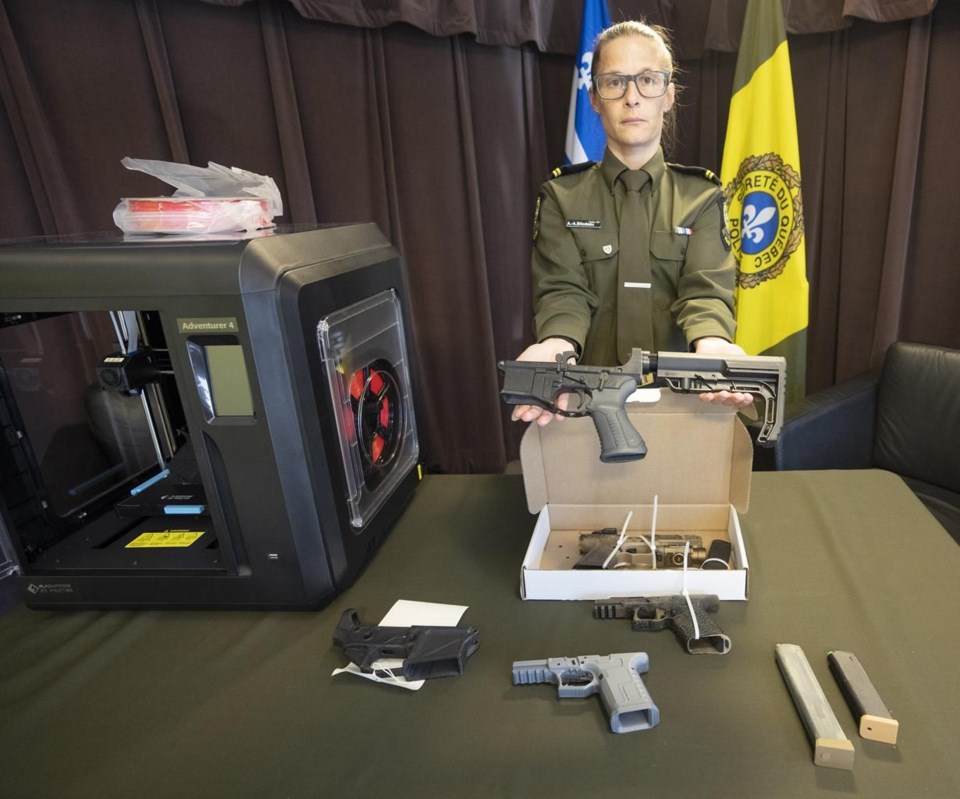FREDERICTON — Even as the technology to produce so-called "ghost guns" becomes less expensive and more widespread, the RCMP is not keeping records on how often the weapons are used in crimes across the country.
Ghost guns are firearms without serial numbers that are assembled from individual parts or 3D printers. They are easy to make and hard to trace, and are increasingly showing up at crime scenes in Canada and the United States.
The RCMP doesn't have a database on 3D guns, printers or how many shootings there have been with the weapons. The force said in an email it has laid charges in several cases in which 3D guns were seized, but it didn't give numbers.
"This presence is consistent with national and international trends observed, where privately made firearms are being used in criminal activity," the email said. It noted that 3D print files exist capable of creating a range of firearms, including assault rifles.
The RCMP said they are aware "anecdotally" of several ghost gun seizures in Canada, but they "do not collect statistics on this."
Blake Brown, a history professor at Saint Mary’s University who studies the history of firearms control in Canada, said national and regional statistics should be kept on how many of the 3D-printed weapons are seized and from what areas. He said the lack of data inflames the gun debate and makes it harder for people to agree on the basic facts.
"With most handguns, if police want to work at it, they can usually trace them — even back to the United States or Europe, wherever they're made," Brown said in a recent interview. "But with these (ghost guns), they could change hands multiple times. It can be very, very difficult to figure out where they originated."
He suggested ghost gun manufacturers and distributors might be discouraged if they faced stiffer criminal penalties.
Police across the continent have been warning people about the guns.
Earlier this year, a Quebec-based anti-gun unit that included RCMP members said it had arrested 45 people and seized 440 guns in raids targeting manufacturers of 3D-printed firearms in eight provinces: Quebec, Ontario, Alberta, British Columbia, New Brunswick, Nova Scotia, Manitoba and Saskatchewan. Last month, a coroner's inquest heard that the weapons used to murder three people in the Montreal area at random in August 2022 were homemade by the killer.
In the United States, the Justice Department has told the Supreme Court that local law enforcement agencies seized more than 19,000 ghost guns at crime scenes in 2021, a more than tenfold increase in just five years.
Last month, New Brunswick RCMP reminded people of the dangers of ghost guns. "Privately made firearms … can appeal to individuals intending to use them for criminal purposes since they do not have a serial number and are difficult to trace,” the Mounties said.
“Parents, educators, businesses and communities may not be aware of the risks related to privately made firearms, which can be made to resemble harmless toys or real firearms. They are also untested, unpredictable and dangerous."
Brown said Canada has rigorous regulations on firearms, particularly handguns. But 3D-printed guns upend regulations because they don't have serial numbers.
Experts say it's relatively easy for someone to make a gun. All it takes is a 3D printer -- which uses a laser to secrete a liquid resin that hardens to form the gun parts -- and instructions, which can be found online. Nothing in the Firearms Act or other laws prohibits a person from possessing a digital blueprint for a 3D-printed gun. But possession of the printed firearm without a licence and registration certificate can lead to seizure of the weapon and criminal charges.
"But ... if there's a market, probably some people will take the risk and try to produce these things," Brown said.
Rod Giltaca of the Canadian Coalition for Firearm Rights, a group that opposed Ottawa’s amendments to strengthen gun laws in Canada, said criminals will use the path of least resistance. With 3D printers readily available, he said, criminals are now turning to technology, along with files and instructions available on the internet.
"The best you can do is make possessing 3D printed parts for firearms … illegal somehow," Giltaca said. "That's still not going to deter people who weren't deterred from shooting other people in the first place."
A.J. Somerset, the Ontario-based author of "Arms: The Culture and Credo of the Gun," said Canada has been dealing with an increase in printed firearms for about 10 years. But the issue seems to have taken on an urgency as ghost guns get easier to make and the sheer volume of new guns makes them harder to trace.
Somerset said it's a matter of time before they are used more often in crimes ranging from gas station robberies to murder. And because they are easy to make and dispose of, they can be manufactured for a specific crime, he said.
The guns are likely to change the patterns of criminal activity, he added. “Print that gun, use it for murder, and then throw it away."
This report by The Canadian Press was first published Oct. 6, 2023.
— With files from The Associated Press.
Hina Alam, The Canadian Press



